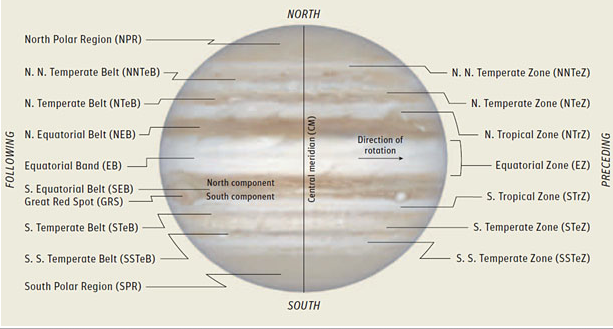June 2017 Skynotes - Jupiter
With the light summer nights looming on us so quickly and here in Cornwall such unpredictable weather it was time put aside the deep sky objects and look at the brightest planet that is well positioned in our skies at the moment, Jupiter.
The conditions were poor with seeing at IV to V at the best plus dodging the clouds and gusts of wind up to 20mph it was quite a challenge to get anything at all. I also set up the telescope on the balcony which after a hot day is about the worse place I could be. Jupiter would frequently disappear off the imaging screen due to a gust of wind only to reappear a fraction of a second later. Anyway here is the result warts and all.
North is up and rotation to the right. Even though the image is poor the belts are clearly seen.

After taking a series of images the best of which is shown I turned to the moon but the turbulence was so bad. I decided to pack up.
However I before retiring for the night I set up for visual viewing.
Despite the poor conditions looking through a 24mm eyepiece (lower magnification than used for the images) it is was surprising what details I could still see.
Todays technology of CCD’s and CMOS devices are amazing but the eye is equally amazing, so adaptable that it is easy to forget how enjoyable visual astronomy is and despite my love of astrophotography an evening spent looking through an eyepiece is still the best and most enjoyable of all even tho the seeing was frustrating.
Christopher summed it up recently in his article on seeing in the April issue of the BAA magazine. “Seeing is sometimes the joy and frequently the bane of the astronomers life” how true that is.

On the rare occasion you get good seeing it is worth waiting for because it just takes your breath away. Unfortunately this night was the latter and very poor. Even so the details of the belts were clearly seen however the whole view was enhanced by the moons of Jupiter Europa, Callisto and Io. (not captured in the image).
Even with the lighter nights Jupiter still makes lovely viewing even with the smallest of telescopes.
If you are interested in Jupiter and want to see some incredible, breathtaking images, I would encourage all to look at the images from Juno on the NASA website. They are revealing a whole new world.
Thanks of your interest.
Clear Skies.
Bob Sayer
Jupiter image 18th May 2017 @ approx 23:11
Telescope 11”NexStar GPS
Camera Skyris 312M
Teleview 2x power mate.
Baader IR block filter.
Capture software - Firecapture. Image is a video stack of approx 1000 frames processed in WinJUPOS, Registax and PhotoShop.
